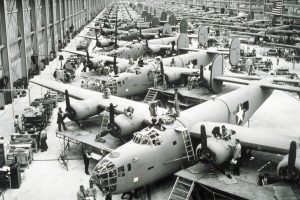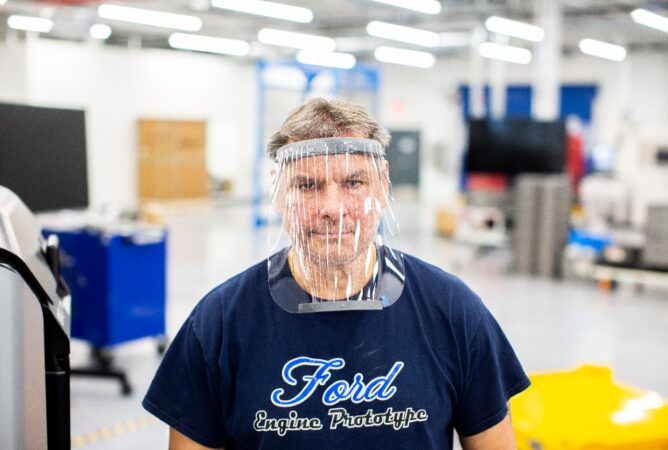Though it never seemed to end, March is back again, ringing in the one-year anniversary of America’s COVID-19 lockdown conundrum. As calls for a few weeks of lockdown turned to months and finally a year, let’s take a trip through history to remember how Detroit and its industry stepped up just as it had in years past.
When the state and country needed it most, automakers in Detroit and the surrounding region immediately began to manufacture PPE, ventilators, and other much-needed supplies for the nation. But, this was not the first instance of the Motor City stepping up in times of crisis, as during World War II, the city’s factories went from creating automobiles to churning out tanks, planes, and weapons for the war overseas.
AN ARSENAL FOR DEMOCRACY AMID TIMES OF WAR

EAGLE BOAT 1 BEING LAUNCHED AT ROUGE
According to the Detroit Historial Society, no city did more to help the allied war cause than Detroit. As the war began following the attack on Pearl Harbor in 1941, Detroit would soon be known as “The Arsenal of Democracy” due to its contribution in the manufacturing of material needed for war.
The term “The Arsenal of Democracy” comes from President Franklin D. Roosevelt, who urged the nation to stand up as one during one of his many fireside chats, stressing the importance of arming allies in the European theater. With the manufacturing capability that it possessed, Detroit quickly transitioned away from creating civilian vehicles to quickly producing weapons and vehicles for the fight.
From large auto manufacturing plants to small tool and die makers, the city was utterly transformed into an arsenal, creating everything from jeeps, tanks, bombers, and fighter planes, to artillery, weapons, helmets, and medicine. According to information, nearly 91 percent of all helmets used in the armor were created in Detroit. Simultaneously, Chrysler’s Detroit Arsenal Tank plant produced half of all tanks manufactured in the country.

1942 B-24 PRODUCTION AT WILLOW RUN
Ford produced a single B-24 bomber every hour on the hour by 1944, while General Motors produced over 2.5 million military use vehicles by wars end. Detroit’s Guardian Building was turned into a Pentagon annex, while 200,000 Detroiters joined the fight overseas.
In total, it’s estimated that over 700,000 Detroiters worked on manufacturing supplies to win the war and nearly 25 percent of all allied supplies came from Detroit.
“Victory Gardens” sprung up amid food rations, while the earliest highways such as the Davison Freeway and I-94 were built to speed up war shipments.
With so many changes underway, Detroit’s developmental path would be forever altered after the war ended in 1945.
AN ARSENAL FOR HEALTH AMID A PANDEMIC LOCKDOWN
Flashforward more than 80 years and Detroit once again stepped up in a time of crisis, but this time, in the face of a far different enemy. As the country prepared to lockdown, Detroit’s industry once again adapted.
Deemed the Arsenal of Health this time around, instead of building tanks, bombs and bullets, masks, ventilators, and face shields were created in facilities that once built trucks and cars. Ford and General Motors worked on manufacturing ventilators, face masks, and other supplies, while Fiat Chrysler began assisting nonprofits with food assistance.
Overall, the Arsenal of Health worked similar to the Arsenal of Democracy of old, serving as a bastion of hope in a time of darkness.
As we look back on this year of crisis, it’s important to remember those we lost while also remembering that Detroit was there just as it’s always been when the country needed us most. More than a tagline for clothes, the past year of struggle has seen Detroit grow stronger, proving that the Motor City truly does hustle harder.
Interested in learning more about the rise of Detroit before the Second World War? Check out our short video on the national bank run that accused in the city throughout the 1930s.
Be sure to subscribe to our newsletter for the latest on all things Detroit and more.





















